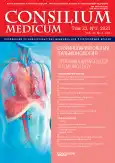Results of treatment for ronchopathy and obstructive sleep apnea syndrome in children with adenoid hypertrophy/vegetations
- Authors: Alekseenko S.A.1,2,3, Karpishchenko S.A.4, Arustamyan I.G.1, Stancheva O.A.1
-
Affiliations:
- Saint Petersburg Research Institute of Ear, Throat, Nose and Speech
- Mechnikov North-Western State Medical University
- Rauhfus Children’s Municipal Multi-Specialty Clinical Center of High Medical Technology
- Pavlov First Saint Petersburg State Medical University
- Issue: Vol 23, No 3 (2021)
- Pages: 222-225
- Section: Articles
- URL: https://journals.rcsi.science/2075-1753/article/view/95437
- DOI: https://doi.org/10.26442/20751753.2021.3.200573
- ID: 95437
Cite item
Full Text
Abstract
Full Text
##article.viewOnOriginalSite##About the authors
Svetlana A. Alekseenko
Saint Petersburg Research Institute of Ear, Throat, Nose and Speech; Mechnikov North-Western State Medical University; Rauhfus Children’s Municipal Multi-Specialty Clinical Center of High Medical Technologyканд. мед. наук, доц. каф. Saint Petersburg, Russia
Sergey A. Karpishchenko
Pavlov First Saint Petersburg State Medical University
Email: karpischenkos@mail.ru
д-р мед. наук, проф. каф. Saint Petersburg, Russia
Irina G. Arustamyan
Saint Petersburg Research Institute of Ear, Throat, Nose and Speechканд. мед. наук, науч. сотр. Saint Petersburg, Russia
Olga A. Stancheva
Saint Petersburg Research Institute of Ear, Throat, Nose and Speechмл. науч. сотр. Saint Petersburg, Russia
References
- Guilleminault C, Tilkian A, Dement WC. The sleep apnea syndromes.Ann Rev Med. 1976; 27 (1): 465-84.
- Karpishchenko S, Aleksandrov A, Sopko O, Arustamyan I. Conservative treatment of snoring and obstructive sleep apnea based on correction of nasal obstruction. Folia otorhinolaryngologiae et pathologiae respiratoriae. 2016; 2: 62-3.
- Hirayama M, Fukatsu H, Watanabe H, et al. Sequential constriction of upper airway and vocal cords in sleep apnoea of multiple system atrophy: low field magnetic resonance fluoroscopic study. J Neurol Neurosurg Psychiatry. 2003; 74 (5): 642-5.
- Блоцкий А.А., Плужников М.С. Феномен храпа и синдром обструктивного сонного апноэ. СПб.: СпецЛит, 2002
- Gozal D, Kheirandish-Gozal L. New approaches to the diagnosis of sleep-disordered breathing in children. Sleep Med. 2010; 11 (7): 708-13.
- Bixler EO, Vgontzas AN, Lin HM, et al. Sleep disordered breathing in children in a general population sample: prevalence and risk factors. Sleep. 2009; 32 (6): 731-6.
- Li AM, So HK, Au CT, et al. Epidemiology of obstructive sleep apnoea syndrome in Chinese children: a two-phase community study. Thorax. 2010; 65 (11): 991-7.
- Бузунов Р.В., Ерошина В.А., Легейда И.В. Оперативные вмешательства на небе при лечении храпа: мифы и реальность. Режим доступа: http://hrap.ru/publication/publication1_82.html
Supplementary files






